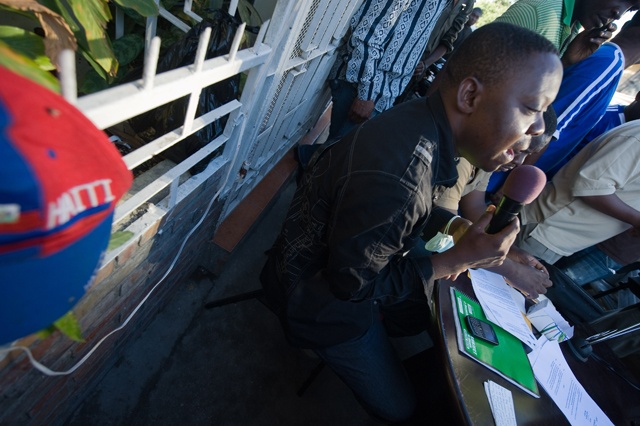Haiti Quake: Watchful Waiting
As the first wave of exhausted news teams rotates out, the story enters a new phase — and news managers need to be prepared to provide informed support.

Radio Caraibes presenter Israel Jacky Cantave broadcasts across the street from the station's damaged building in Port-au-Prince in the wake of the devastating earthquake on Jan. 12, 2010.
A week after the worst natural disaster to strike the Western Hemisphere in decades, news coverage of Haiti’s earthquake is moving into a second phase. Exhausted news teams who arrived in Port-au-Prince with emergency crews are preparing to rotate out; assignment desks are grappling with how to keep covering a story as it moves from breaking news into a long, slow recovery.
As the Haiti story moves from crisis to recovery, news organizations are also beginning to ask how to best support the journalists who spent the last week working amid the devastation, chaos and stench of mass death. But while the challenges to those on scene in Haiti are clear, this is also a good time to pay attention to those back in the newsroom.
Start with a critical part of the news support team, routinely overlooked when considering the impact of a difficult story like Haiti: the picture desk. Whether it is the technicians and producers who monitor raw, unedited video footage as it comes off the satellite or photo editors who review thousands of still pictures, in times of crisis those who process raw images face distinct occupational risks.
Simply put, a steady diet of graphic and horrifying images or audio can be overwhelming. Psychologists have long recognized vicarious traumatization — the symptoms of traumatic stress or other psychological distress in individuals who absorb toxic levels of horror through the eyes — or camera lenses — of others, such as psychotherapists, human-rights investigators or journalists. While the source of distress may be second-hand, the impact is real and sometimes enduring.
On a 24/7 story like Haiti, it’s important that in-studio personnel pace their work, take frequent breaks, share concerns that arise and be on the lookout for colleagues who may be unexpectedly derailed by distressing images.
This is also a good time to sharpen news managers’ awareness of trauma and for newsroom leaders to set the tone for a resilient newsroom both for teams on the ground in Haiti and those rotating home. News organizations such as the BBC, the Australian Broadcasting Corporation and NPR now routinely arrange expert trauma-awareness briefings for their managers; if your newsroom has never done so, or needs a brush-up, the sheer scope of horror and destruction in Haiti might be a good reminder to make it happen.
And what about when that first wave of reporters, producers and field staff return from Haiti?
Don’t assume that everyone on your Haiti team immediately needs to see a mental health professional. Instead, focus on public and private acknowledgement of the assignment’s importance; make it clear to the whole newsroom that emotional responses to a story like Haiti, whether by those reporting or those working on the desk, are normal human reactions, not a sign of weakness. Encourage news teams to talk among one another as colleagues, and with you in private; and make it clear that management supports anyone who seeks confidential professional counseling.
Dart Centre Australasia in Melbourne offers these management tips for the aftermath of an exceptionally traumatic assignment, which apply particularly to the Haiti catastrophe:
- It’s essential that managers make contact with anyone on their staff who has been through a distressing experience. This is good management anyway, but is especially important in the aftermath of trauma.
- Send somebody to meet and greet those returning from overseas or long absences.
- Acknowledge with thanks, lunch, drinks, public recognition or e-mails. A simple "thank you" goes a long way to assist well-being and better work performance. Debrief news teams returning from trauma reporting: Talk to them about how it was, both logistically and emotionally. Don’t be afraid to talk about strong emotional reactions — these are normal.
- Encourage staff to maintain support from family, friends and social networks.
- Remind them that distress is a typical human response following trauma exposure. Some typical responses: sleeplessness, upsetting dreams and intrusive thoughts of the event; avoidance, numbness and feeling that bad things are about to happen; being jumpy and easily startled; anger, hyperactivity or difficulty concentrating; physical reactions such as sweating, rapid heartbeat, dizziness or nausea when reminded of a traumatic event.
- Offer counseling if a staff member appears overwhelmed or if you feel out of your depth.
It's important to check in with employees again in three to four weeks to see if any of these symptoms are still occurring. If so, refer to a trauma specialist. During this time, engage in "watchful waiting" (keeping a quiet eye on them). Any behavior that is out of character for your staff member is an indicator that all is not well.
Remember that you are also part of the "ripple effect of trauma." Notice your own emotions and don’t be surprised if you also feel some of the above symptoms or others that seem out of the ordinary. Make sure you apply self-care and talk to someone as well.

































































































